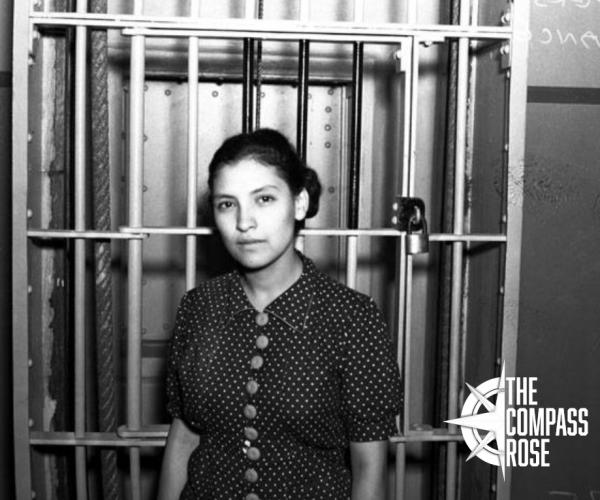
by Michael Barera


by Michael Barera
The purpose of The Compass Rose is to raise awareness of Special Collections' resources and to foster the use of these resources. The blog series also reports significant new programs, initiatives, and acquisitions of Special Collections.
This blog post is the first part in a two-part series on Emma Tenayuca. The second part, Emma Tenayuca and the 1938 San Antonio Pecan Shellers' Strike, will be published next Monday, March 15.
Special thanks to the San Antonio Express-News and the University of Texas at San Antonio (UTSA) Libraries Special Collections for their permission to use The San Antonio Light's photographs of Emma Tenayuca that illustrate this article.
In continuing celebration of Women’s History Month, this week we are celebrating the life, labor leadership, and legacy of Emma Tenayuca, a prominent Latina labor leader from San Antonio. This two-part blog series features numerous secondary sources from our small Emma Tenayuca Collection. As noted above, the photographs are thanks to the San Antonio Express-News and the UTSA Libraries Special Collections. UTSA also has a video oral history and an audio oral history of Tenayuca, while her papers are at Texas Woman's University in Denton.
Latina labor leader Emma Tenayuca was born in San Antonio in 1916 (McDonald 1990 p. 55). Before turning eight years old, she was attending political rallies on the plaza in front of the city's Milam Square (Tenayuca 1983 p. 8). While a high school student, she lived with her maternal grandfather, Francisco Zepeda, who introduced her to socialism (Blackwelder 1984 p. 147) (McDonald 1990 p. 55). Scholars Roberto Calderon and Emilio Zamora elaborated that Tenayuca credited her relatives for inspiring "the ideas and concerns they would later elaborate on behalf of the Mexican worker in Texas” (Calderon and Zamora 1986 p. 31). While attending Breckenridge High School in San Antonio, Tenayuca was a very active and engaged student, even forming and participating in a reading group (McDonald 1990 p. 56).
After graduating, she took a job as an elevator operator (Blackwelder 1984 p. 147), working for just $1 a day (Tenayuca 1983 p. 9) (McDonald 1990 p. 57). Tenayuca was planning on attending college after graduating from high school, but was unable to do so due to the impact of the Great Depression on her grandfather’s finances (McDonald 1990 p. 57). Reminiscing in 1984, Tenayuca recalled that her “grandparents’ attitude…formed my ideas and actually gave me the courage later to undertake the type of work I did in San Antonio” (Calderon and Zamora 1986 p. 38). Describing her family’s long connections to both indigenous people in the Americas and early Spanish migration to what is now Mexico and Texas, Tenayuca remarked in 1983 that “I am satisfied that we [her family] have been here quite a long time” (Tenayuca 1983 p. 7).
Journalist Tom Bell noted that Tenayuca had the ability “to reach people and stir them up” (Bell 1986 p. 10), while scholar Julia Kirk Blackwelder similarly called her “an energetic leader and a fiery speaker” (Blackwelder 1984 p. 147). Tenayuca herself observed that “a lot of people found out that it was hard to push me around” (Calderon and Zamora 1986 p. 38). She elaborated, saying “I think it was the combination of being a Texan, being a Mexican, and being more Indian than Spanish that propelled me to take action. I don’t think I ever thought in terms of fear. If I had, I think I would have stayed home” (Calderon and Zamora 1986 p. 40). As a leader, Tenayuca emphasized her pragmatic approach to organization (Tenayuca 1983 p. 14).
In 1932, Tenayuca took part in the spontaneous Finck cigar workers strike in San Antonio, when she was just 16 years old (Bell 1986 p. 10) (Calderon and Zamora 1986 p. 33) (Tenayuca 1983 p. 10). At the time she was a member of the local chapter of the Workers Alliance, a national organization formed by the Communist Party of the United States. During the strike, she was arrested and jailed (Bell 1986 p. 10). Tenayuca had a friend who was a nun who once remarked to her, “Emma, I have to read the papers to see whether you are in or out of jail” (Calderon and Zamora 1986 p. 40). It was the experience of being jailed that caused Tenayuca to realize “how difficult it would be to make this [San Antonio] a union town” (Tenayuca 1983 p. 9). At the time, as Bell observed, being a Communist “meant you got arrested for striking in a show of support with cigar workers” (Bell 1986 p. 10).
The Finck strike had an impact on Tenayuca’s worldview, too, as it aligned her thinking more closely with anarchism. It also familiarized her with the San Antonio branch of the Workers Alliance, of which she quickly became a leader (McDonald 1990 p. 59). An organization of unemployed and underemployed people (McDonald 1990 p. 59), the Workers Alliance also served as a mediator between the New Deal-era Works Progress Administration (WPA) and people in need of work (McDonald 1990 p. 60). In 1934 and 1935, Tenayuca played a crucial role in the formation of two International Ladies’ Garment Workers Union (ILGWU) locals in San Antonio (Calderon and Zamora 1986 p. 33). In 1937, Tenayuca led a march of 5,000 people on behalf of the Workers Alliance. Remarkably, none of the marchers were arrested, which scholar Dedra S. McDonald credits to Tenayuca’s leadership (McDonald 1990 p. 60).
Blackwelder describes Tenayuca’s career as a labor leader as “relatively short," observing that she first obtained a leadership position in the local labor movement in 1936 but was forced to retire from public labor activism in 1939 due to public backlash against her communist affiliation (Blackwelder 1984 p. 147). She was elected initially to lead organizing efforts among women for a union affiliated with both the San Antonio Trades Council and the American Federation of Labor (AFL), but she soon began to build support for communism among men as well as women active in the labor movement (Blackwelder 1984 p. 147). In 1937, she became a member of the Workers Alliance's Executive Committee (Calderon and Zamora 1986 p. 33). Also in 1937, Tenayuca married Homer Brooks, a Pennsylvania native who was secretary of the Texas Communist Party (McDonald 1990 p. 61-62).
This blog post is the first part in a two-part series on Emma Tenayuca. The second part, Emma Tenayuca and the 1938 San Antonio Pecan Shellers' Strike, will be published next Monday, March 15.
Bell, Tom. 1986. “The Pecan Strike.” Current, May 22, 1986.
Blackwelder, Julia Kirk. 1984. Women of the Depression: Caste and Culture in San Antonio, 1929-1939. College Station, Texas: Texas A&M University Press.
Calderon, Roberto, and Emilio Zamora. 1986. “Manuela Solis Sager and Emma Tenayuca: A Tribute.” Chicana Voices: Intersections of Class, Race, and Gender, 30–41.
McDonald, Dedra S. 1990. “Chicanas at the Forefront of Labor Organization: A Look at Emma Tenayuca’s Role as an Activist.” The Wittenberg Review, 55–67.
Tenayuca, Emma. 1983. “Living History: Emma Tenayuca Tells Her Story.” The Texas Observer, October 1983, 1, 7–15.
Add new comment